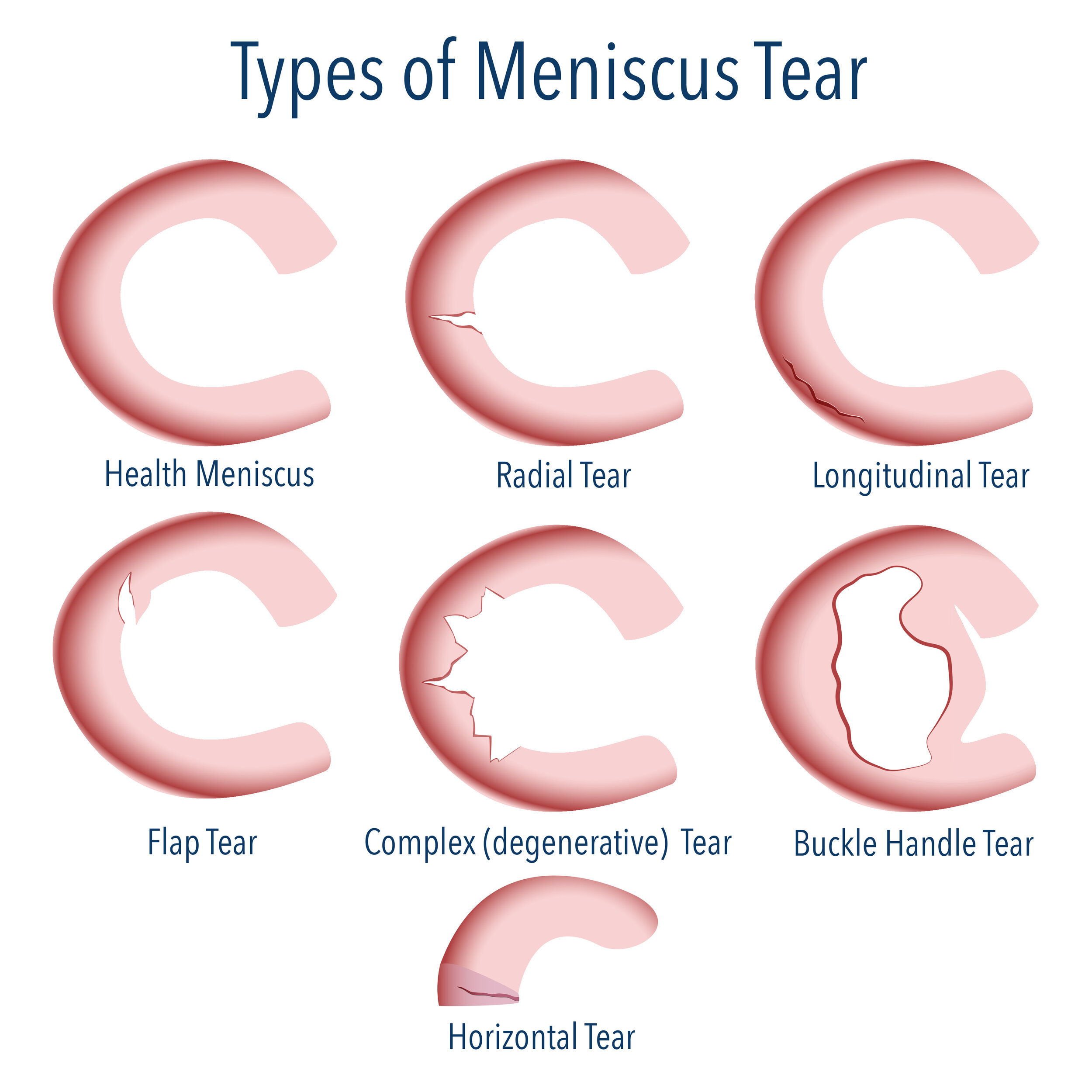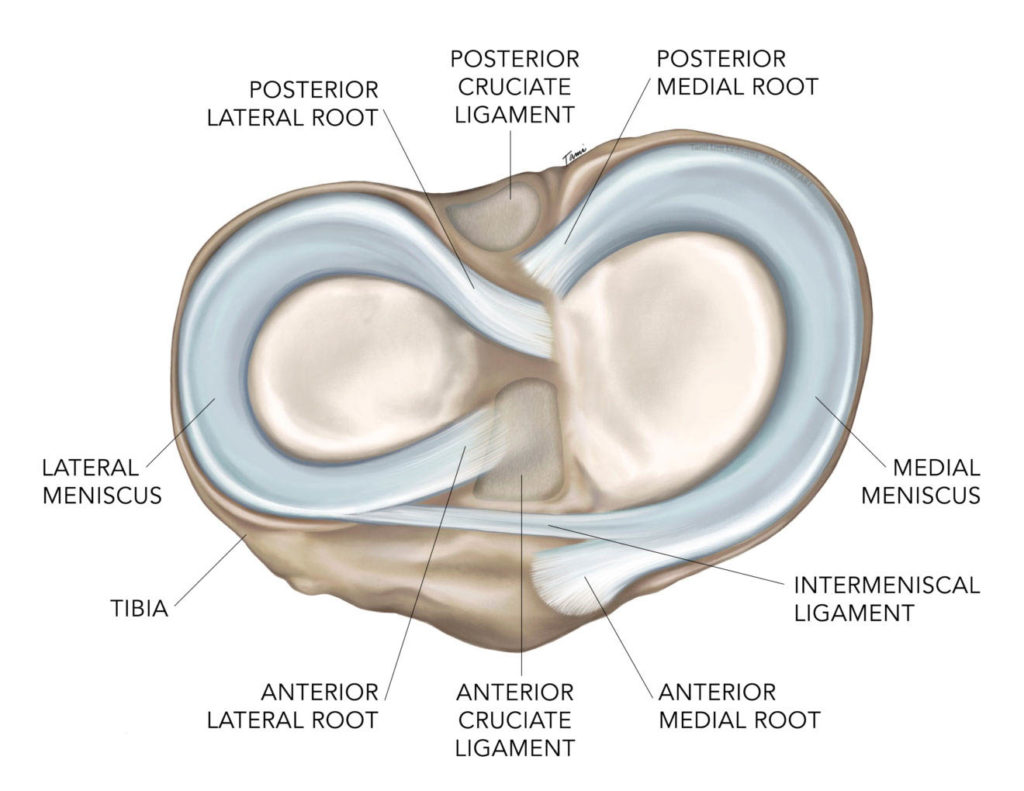Anatomy and Function of the Meniscus: Meniscus Tear

The meniscus is a C-shaped piece of cartilage that acts as a shock absorber and helps distribute weight evenly within the knee joint. It plays a crucial role in maintaining the stability and smooth movement of the knee.
Location and Structure
The meniscus is located between the femur (thigh bone) and the tibia (shin bone) in the knee joint. There are two menisci in each knee: the medial meniscus (on the inner side of the knee) and the lateral meniscus (on the outer side of the knee). Each meniscus is made of a tough, rubbery type of cartilage called fibrocartilage. The meniscus is not directly connected to the bones, but it is attached to the joint capsule and ligaments surrounding the knee.
Role in Weight Distribution and Shock Absorption
The meniscus acts as a shock absorber, cushioning the impact of weight bearing and protecting the knee joint from wear and tear. The meniscus also helps distribute weight evenly across the joint surface, reducing stress on the cartilage and bones.
Role in Joint Stability
The meniscus helps stabilize the knee joint by deepening the articular surface, which allows for greater stability and prevents the femur from sliding off the tibia. The meniscus also acts as a guide for the femur during movement, ensuring smooth and controlled motion.
Zones of the Meniscus
The meniscus is divided into different zones based on its structure and blood supply.
- Inner Zone (Red-Red Zone): This zone is located at the outer edge of the meniscus and has a good blood supply. It has a higher healing potential compared to other zones.
- Middle Zone (Red-White Zone): This zone has a limited blood supply and a lower healing potential.
- Outer Zone (White-White Zone): This zone has no blood supply and very limited healing potential.
Meniscus Zones, Meniscus tear
| Meniscus Zone | Description | Function | Common Injuries |
|---|---|---|---|
| Inner Zone (Red-Red Zone) | Outer edge of the meniscus with a good blood supply. | Provides stability and distributes weight evenly. | Tears, especially those involving the outer edge of the meniscus. |
| Middle Zone (Red-White Zone) | Has a limited blood supply. | Cushions the knee joint and helps with joint stability. | Tears, which may heal slowly due to limited blood supply. |
| Outer Zone (White-White Zone) | Has no blood supply. | Provides shock absorption and stability. | Tears, which are difficult to heal due to lack of blood supply. |
Types and Causes of Meniscus Tears

The meniscus, a C-shaped piece of cartilage in your knee, acts as a shock absorber and helps stabilize your knee joint. A meniscus tear is a common injury that occurs when this cartilage is torn. These tears can range from small, minor tears to large, complex tears, and they can be caused by a variety of factors.
Types of Meniscus Tears
Meniscus tears can be classified based on their location, shape, and severity.
- Location: Tears can occur in either the medial (inner) or lateral (outer) meniscus. Medial meniscus tears are more common because the medial meniscus is more firmly attached to the tibia (shin bone) and less mobile than the lateral meniscus.
- Shape: Tears can be longitudinal, transverse, radial, or flap tears.
- Longitudinal tears run along the length of the meniscus.
- Transverse tears run across the width of the meniscus.
- Radial tears are a combination of longitudinal and transverse tears.
- Flap tears occur when a portion of the meniscus is torn off and left loose in the joint.
- Severity: Tears can be classified as Grade I, Grade II, or Grade III.
- Grade I tears are minor tears that involve only a small portion of the meniscus. They are often painless and may not require treatment.
- Grade II tears are more significant tears that involve a larger portion of the meniscus. These tears can be painful and may limit your ability to move your knee.
- Grade III tears are the most severe type of tear. They involve a complete tear of the meniscus, which may detach a portion of the cartilage from the knee joint.
Causes of Meniscus Tears
Meniscus tears can be caused by a variety of factors, including:
- Sports Injuries: Meniscus tears are common in athletes, particularly those who participate in sports that involve pivoting, twisting, or sudden changes in direction. Examples include basketball, football, soccer, and skiing.
- Example: A basketball player pivoting on his foot and feeling a sharp pain in his knee may have a meniscus tear.
- Degenerative Changes: As we age, the meniscus can wear down and become more susceptible to tears. This is especially true for individuals who are overweight or have a history of knee injuries.
- Example: A 50-year-old woman with osteoarthritis in her knees may experience a meniscus tear due to the degeneration of the cartilage.
- Trauma: A direct blow to the knee, such as a car accident or a fall, can cause a meniscus tear.
- Example: A pedestrian hit by a car may suffer a meniscus tear as a result of the impact.
Mechanisms of Injury for Different Types of Meniscus Tears
The mechanism of injury for a meniscus tear depends on the type of tear.
- Longitudinal tears are often caused by a twisting motion of the knee, while the foot is planted on the ground.
- Example: A football player planting his foot and then pivoting to avoid a tackle may experience a longitudinal meniscus tear.
- Transverse tears are often caused by a direct blow to the knee, such as a fall or a car accident.
- Example: A skier falling and landing directly on their knee may suffer a transverse meniscus tear.
- Radial tears are often caused by a combination of twisting and direct impact forces.
- Example: A basketball player landing awkwardly after a jump may experience a radial meniscus tear.
- Flap tears are often caused by a sudden, forceful twisting motion of the knee.
- Example: A soccer player twisting their knee while trying to kick the ball may experience a flap meniscus tear.
Symptoms and Diagnosis of Meniscus Tears

A meniscus tear can be a real pain in the knee, literally. It can cause a range of symptoms, from mild discomfort to debilitating pain. Knowing the signs and how to diagnose a meniscus tear is crucial for getting the right treatment and getting back on your feet.
Common Symptoms of Meniscus Tears
The symptoms of a meniscus tear can vary depending on the severity of the tear and the location of the tear in the meniscus. However, some common symptoms include:
- Pain: You might experience pain in your knee, especially when you put weight on it, twist your knee, or squat. The pain may be sharp or dull, and it can worsen over time.
- Swelling: Your knee may swell after an injury or even after a period of activity. This swelling can make it difficult to bend or straighten your knee.
- Stiffness: You might find it difficult to bend or straighten your knee, or you might experience a feeling of locking or catching in your knee.
- Clicking or Popping: You may hear a clicking or popping sound in your knee when you bend or straighten it.
- Giving Way: You might feel like your knee is giving way or buckling, especially when you are walking or standing.
Diagnostic Procedures for Meniscus Tears
Diagnosing a meniscus tear involves a combination of physical examination, imaging tests, and sometimes, arthroscopy.
Physical Examination
A physical exam can help your doctor assess the extent of your knee injury and rule out other potential causes of your symptoms. This may involve:
- Palpating the knee: Your doctor will feel around your knee joint to check for tenderness, swelling, and any unusual movement or clicking.
- Assessing range of motion: Your doctor will ask you to bend and straighten your knee to assess your range of motion and look for any limitations.
- Performing specific tests: Your doctor may perform specific tests, such as the McMurray test, to assess for a meniscus tear.
Imaging Tests
If your doctor suspects a meniscus tear, they may order imaging tests to confirm the diagnosis. Common imaging tests include:
- X-ray: X-rays can help rule out other conditions, such as fractures, but they don’t always show a meniscus tear.
- Magnetic Resonance Imaging (MRI): MRI is a more sensitive imaging test that can clearly show the structure of the meniscus and reveal a tear.
Arthroscopy
Arthroscopy is a minimally invasive surgical procedure that involves inserting a small camera and surgical instruments into the knee joint. This procedure can be used to diagnose a meniscus tear and, if necessary, repair the tear.
Diagnosing a Meniscus Tear: A Step-by-Step Guide
Here’s a step-by-step guide on how a healthcare professional would diagnose a meniscus tear:
- Medical History: The doctor will ask about your symptoms, including when they started, what makes them worse, and if you’ve had any recent injuries.
- Physical Examination: The doctor will perform a physical exam to assess your knee joint, including palpating for tenderness, checking your range of motion, and performing specific tests for meniscus tears.
- Imaging Tests: Depending on the findings of the physical exam, the doctor may order imaging tests, such as X-rays or an MRI, to confirm the diagnosis.
- Arthroscopy: In some cases, an arthroscopy may be performed to confirm the diagnosis and to repair the tear.
Flowchart Illustrating the Diagnostic Process
A flowchart can help visualize the diagnostic process for a meniscus tear:
[Insert image of a flowchart illustrating the diagnostic process for a meniscus tear. The flowchart should include the following steps: 1. Patient presents with knee pain and swelling. 2. Doctor takes medical history and performs physical exam. 3. Doctor orders imaging tests (X-rays or MRI). 4. If imaging tests confirm a meniscus tear, doctor may recommend treatment options. 5. If imaging tests do not confirm a meniscus tear, doctor may order further tests or refer the patient to a specialist.]
A meniscus tear, a common knee injury, can be particularly devastating for athletes, especially those in high-impact sports like football. The Minnesota Vikings, a team known for its aggressive style of play , have certainly seen their share of meniscus injuries throughout their history.
While a meniscus tear can sideline a player for weeks or even months, with proper rehabilitation, many athletes can return to the field and continue to perform at a high level.
A meniscus tear, a common knee injury, can sideline athletes for weeks or even months. The severity of the tear determines the recovery time, as seen in the case of jj mcarthy injury , which has significantly impacted the Michigan Wolverines.
While rehabilitation for a meniscus tear can be challenging, with proper care and dedication, athletes can return to their sport and regain full functionality.
